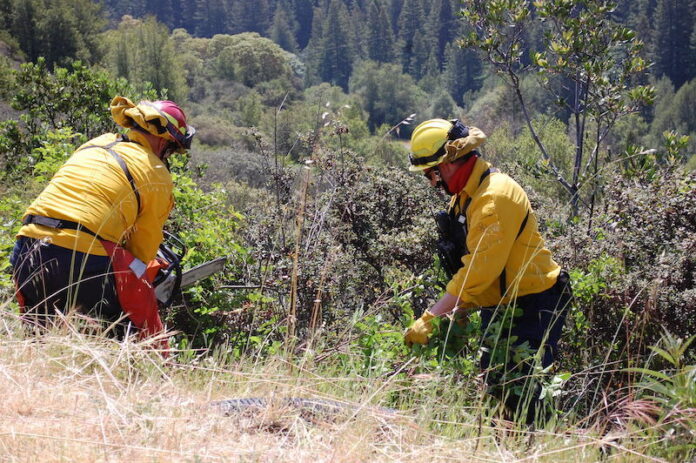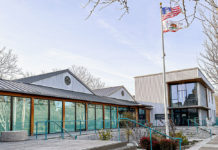
This summer is shaping up to have all of the key ingredients of an early and dangerous fire season. Exceptionally dry brush coupled with severe to extreme drought conditions in Sonoma County has fire chiefs worried about the potential for large wildfires, especially along the ridgetops of the coastline where it’s unusually dry for this time of year.
“We’re very concerned about the eastern ridgetops of the county that didn’t burn during the Kincade and Glass Fires, and a lot of the focus of local fire chiefs in Sonoma County this year is on the ridgelines along the Russian River communities, Occidental and out to the coast,” said Sonoma County Fire District Chief Mark Heine.
He said the fuels at the coastline are normally very moist due to the fog and the low marine lawyer, but this year they’re exceptionally dry.
“The readings are very low so we’re very concerned about a repeat of large fires on the coastline of Sonoma County and there is a history out there of major wildfires, we just haven’t seen it burn in a very long time,” Heine said.
Northern Sonoma County Fire Protection District Chief Marshall Turbeville, who’s also a CalFire Sonoma-Lake-Napa Unit battalion chief, said he’s also concerned about the western and northern most part of Sonoma County.
“My real concern is the forests, the western part of Sonoma County and the northern part of Sonoma County. Those are areas that didn’t have a chance to recover this past winter and for the ground to get wet. All the limbs and twigs and branches that are stacked out there in the forest are just way drier than they should be for this time of year. You combine that with a critical weather event like a Red Flag event where it’s really warm, dry and windy then that’s hard … All of these ingredients are not in our favor,” Turbeville said.
In terms of a statewide outlook, conditions and models for the summer fire season look grim. “Unfortunately, all of the data that we use to make predictive modeling around fire season says we’re looking at another very intense fire season in California,” Heine said.
The alarming drought conditions don’t help the situation either. “Much of the state is in a severe drought category right now. The city of Santa Rosa average rainfall for this time of year is about nine inches below the average rainfall and the last big drought that we experienced in Northern California was back in the mid-1970s and we’ve received less rain then we received back then. Most of Sonoma County is already in the severe drought category and a small sliver of it, about 5% of it, is in the extreme drought category,” Heine said.
On April 21, standing on a parched section of Lake Mendocino, Gov. Gavin Newsom declared a drought emergency for the Russian River watershed, which spans Mendocino and Sonoma counties.
Heine said the huge impacts of drought are on agriculture and the ability to feed and water livestock, but another significant challenge will be the incredibly dry brush and fire fuels.
“We’re concerned about the grass and the trees, and the brush is exceptionally dry. There’s one main data source that we track very closely that’s called an energy release component, that’s basically a fancy way of looking at the amount of moisture in the grass fuels and trees, and it’s already right now at historic low levels. What’s very disconcerting is how dry everything is right now. We’re still in April … We normally don’t see that until about October or November,” Heine said.
Turbeville echoed Heine’s concerns regarding the dry conditions. He said the ground is dry and the plants are even drier.
“We’re looking at a very dry situation, we’re looking at severe to extreme drought conditions and unfortunately that all comes together to create a very dangerous fire season,” Heine said. “It’s my 40th year in the fire service and I’ve never seen wildfire conditions in my entire career than what we’ve seen in the last few years and I don’t think this year is going to be any different.”
The Mendocino-Sonoma area has already seen a wildfire this month with the 200-acre Turnout Fire that started on April 19 in southwest Mendocino County between Ukian and Boonville.
According to CalFire, the fire was contained to burn in oak woodland brush, but fire crews were challenged with the steep and rugged terrain of the area.
There have also been a few escaped controlled burns. On March 26, the Northern Sonoma County Fire District responded to the scene of an escaped controlled burn on Canyon Road. Forward progress was stopped and the fire was contained.
“For us in the firefighting community, the number of controlled burns that escape their boundaries is an early indication as to how receptive the grass, brush and trees are to fire so if you have trouble containing a controlled burn like that that’s well within fire lines, that’s an early indication that we’re facing a very dangerous fire season,” Hein said.
For the Tubbs, Kincade, Walbridge and Glass fire burn scars, the threat of fire is still there but it is lesser of a threat than in areas that haven’t burned .
“The fire threat is still there but it’s not as likely that we’d see an intense fire burning through those areas because a lot of that surface fuel, grass and brush, has already been burned off. If there’s a fire near a burn scar those burn scars can actually act as a fire break for us, but it depends on how intense that fire was,” he said.
Preparing for wildfire
With the prospect of an intense fire season on the way, preparing for wildfire is important now more than ever.
“It comes down to what we can control. We can’t control the weather, we can’t control the wind and we can’t control the topography, but we can control the fuels. The more vegetation management, the better. Start off small each week, fill up your green bin, move all combustibles away, cut back vegetation, clean out any dead vegetation and clean gutters, separate plants out,” said Healdsburg Fire Department Division Chief and Fire Marshal Linda Collister.
On April 21, Collister and a team of firefighters from the Healdsburg Fire Department, the Northern Sonoma County Fire District and CalFire Sonoma-Lake-Napa Unit, prepared a property on Chemise Road in the western area of unincorporated Healdsburg for a prescribed burn.
The 35-acre prescribed burn helped to clear dry vegetation and to create a fuel break between homes on the 5000 block of Chemise Road.
Before starting the burn from a steep slope around 11 a.m., Collister pointed out all the things that homeowners can do to better prepare their home for wildfire as she prepped a home near the prescribed burn.
Patio furniture cushions should be put away along with other flammable materials such as pool noodles, gutters should be cleaned, plants should be spaced apart and defensible space between 30 and 100 feet should be implemented.
It’s also a good idea to have fire resistant landscaping such as sage, French Lavender and others. The CalFire “Ready for Wildfire” website has a comprehensive list of fire resistant landscaping and materials.
Homes should also have dual-pane windows, vent coverings and gutter guards. Sturdy materials such as metal roofing and fiber cement wall siding or fire retardant treated wood should also be used in lieu of wood paneled siding or wood or shingle roofs.
The Chemise Road prescribed burn is Northern Sonoma County Fire District’s fourth prescribed burn in the area since March 30.
“The previous three burns totaled about 40 acres, once completed these 75 acres will extend from the edge of the Walbridge Fire creating a fire break that should stop or slow the future progress of fires burning from north to south,” according to the Northern Sonoma County Fire District.
Fuel breaks and prescribed burns have also been taking place on the north side of Healdsburg on Fitch Mountain, however, soon prescribed burns won’t be a safe way to manage fire fuels.
“Right now, people should be doing their vegetation management, their defensible space in the areas around their home. By June 1 or mid-June, it’s not going to be safe. You may be able to still get a permit for burning, but you just really have to think about how you’re doing the burn pile and how you’re going to be safe about it,” Turbeville said. “The burn pile option is going to go away, but there are other options whether people want to sign up for the free county chipper or do whatever they need to do. If you want to do it (burn piles) do it soon. We don’t want people doing this in the middle of summer or on dry days.”
“All of the fire agencies are doing a lot on the mitigation and prevention front from community outreach and helping people create their own defensible space, to trying to create larger fuel breaks around communities, to doing prescribed burns in a very controlled environment so we can remove some of this dangerous vegetation,” Heine said.
He continued, “The truth of the matter is when these large wildfires start as we’ve seen over the last three years, it’s exceptionally challenging to be able to contain these fires in the early stages. And with fuels this dry and if we get these off-shore wind events then it’s just a horrible combination.”
Heine said they’re also adding additional staffing and firefighting resources during those peak threats and during Red Flag Warnings along with CalFire partners who are trying to really enhance their air attack program and put more firefighters in fire stations.
Turbeville and Heine said if a fire does occur, people should be ready to evacuate and should already have an evacuation plan in place as well as a go-bag with essentials such as non-perishable food, water, medications, portable radio, copies of important documents and dog and cat food if applicable.
“It’s important to bring it down to an individual family’s preparedness. Folks should be looking at their properties now, their residences and their businesses, and make sure they have defensible space. They can contact our office and we’re always happy to send a fire inspector out and give some education and ideas on how to make your property safe,” Heine said.
He also reiterated the need to talk as a family about an evacuation plan and where you’d go if an evacuation order is given.
“We never want to issue evacuation orders, we try desperately to avoid that situation, but if you do receive an evacuation order from us you need to leave immediately. Don’t delay to grab a few more things, leave immediately,” Heine said.
Turbeville said folks should also be signed up for SoCo Alert and Nixle.
“We always talk about the worst fire season ever and how bad it’s going to be, but every year is going to be a potential for having a bad fire. With that mindset going into the next couple of months and into fall, we need to be best prepared as we can be,” Turbeville said.







